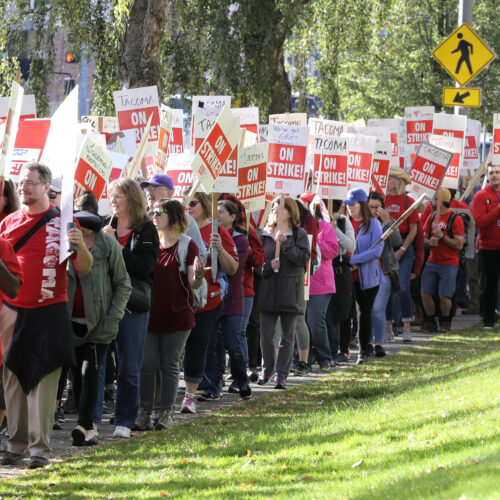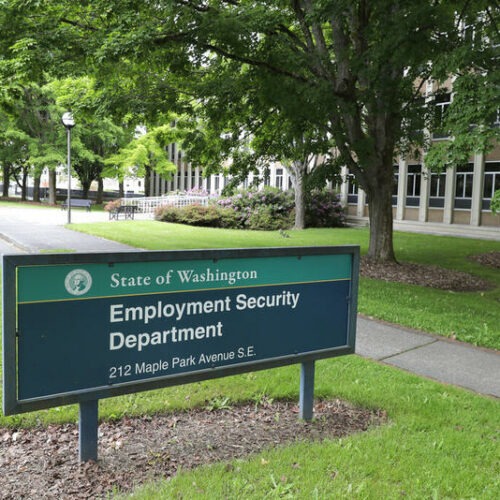
Surge In Unemployment Continues As Clunky State Systems Await Upgrades
READ ON
QUICK LINKS FOR UNEMPLOYMENT:
–Washington Employment Security Department
–Oregon Employment Department
–Idaho Department of Labor
Fresh numbers of initial claims for jobless benefits showed some moderation in the past week in the staggering wave of layoffs across the Pacific Northwest caused by the coronavirus pandemic. But the level of unemployment claims continues to hover at record levels, as reported Thursday by the state labor and employment departments of Oregon, Washington and Idaho.
The sobering numbers were accompanied by some slivers of hope for the newly jobless, many of whom have struggled to draw unemployment because claims processing systems are overloaded and telephone hotlines jammed.
“While we have paid out so much into people’s pockets and into the economy, people are still in deep need,” Washington State Employment Security Department Commissioner Suzi LeVine said Thursday as she announced an imminent expansion in eligibility and benefits. “We know there are hundreds of thousands, if not more, who will now be eligible for unemployment assistance. We are looking forward to this expansion.”
Washington’s Employment Security Department plans to shut down its computer system and telephone hotlines on Saturday to update eligibility criteria and temporarily add an extra $600 per week to nearly all checks. These are key elements of the federally funded expansion of the unemployment safety net included in the massive $2 trillion coronavirus pandemic relief package approved by Congress late last month.
Previously denied part-timers, gig economy workers, freelancers and independent contractors whose work has dried up can soon file for jobless benefits. The door opens on different dates in different states, depending on how difficult it is to update clunky state government claims systems.
The fix can’t come soon enough for former restaurant server Katrina Thiessen of Thurston County, Washington. Thiessen was laid off in mid-March when the seafood chain where she worked part time had to close. Thiessen qualifies for benefits under the expanded eligibility criteria that Congress funded last month, but she cannot collect anything until Washington state updates its computer software.
“It is absolutely ridiculous to keep individuals and families waiting six weeks before they get their unemployment claims accepted and funds distributed,” Thiessen said in an email. “This is wrong.”
Oregon’s Employment Department has not offered a firm date when it will complete the update to its claims system to account for expanded eligibility under the federal pandemic relief package, formally known as the CARES Act.
The agency did crow about successfully adding the $600 extra weekly benefit to unemployment checks that went out this week. Virtually everyone who is on unemployment gets the extra payout through July.
Idaho won’t have its system updated to pay benefits to people who fall under the expanded eligibility criteria until May.
Thursday’s release of initial jobless claims capped a month of surging unemployment that is without precedent in its velocity. The initial claims reported by Idaho, Oregon and Washington state for the week that ended April 11 were down a bit from a late March peak — but still far higher than the worst week of the Great Recession. This week’s initial claims, when added to the three prior weeks, add up to nearly one million jobs abruptly vaporized by the coronavirus shutdown across the three Northwest states.

Laid-off restaurant worker Katrina Thiessen is frustrated by the weeks-long delay in having her unemployment claim approved. CREDIT: Tom Banse/N3
“My concern is that we are seeing initial data showing that this recession is moving well beyond tourism, restaurants, airlines and hotels,” said workforce economist Christian Kaylor of the Oregon Employment Department. “My other concern is consumer confidence.”
In an interview Thursday, Kaylor said he was skeptical about how quickly consumers will feel comfortable about going out again and opening their wallets to lead the country out of a coronavirus recession once stay-at-home orders relax.
Federal funding for this year allows Northwest states to add 13 additional weeks beyond the normal 26-week limit on state unemployment benefits.
A programmer recently laid off by chipmaker Intel in Hillsboro, Oregon, said he immediately pursued several promising leads to new jobs, but then “everything froze” as economic uncertainty ramped up.
Benjamin Koga-Winn, 28, applied for unemployment benefits in early April but has not been able to collect benefits because of a glitch in the verification of his work and wage history. He said phone calls and emails to resolve the problem have gone unanswered.
“I could get by with the savings I have for a little bit,” said the father of a two-year-old. “But the speed bump would be flattened if the system worked better.”
Unemployment offices will allow claims to be backdated for workers who were unable to file earlier because of glitches. LeVine said applicants will get the benefits they are owed paid retroactively. The Washington state and Oregon employment agencies are in the midst of hiring, training and deploying hundreds of additional customer service and claims processing agents.
Democratic U.S. Rep. Earl Blumenauer of Portland leveled additional criticism of his home state’s unemployment department Wednesday because it is not waiving the traditional “waiting week” between a laid-off worker’s last paycheck and the beginning of benefit payments.
“The CARES Act provides for full federal funding through 2020 for the total amount of unemployment compensation paid to individuals for their first week of unemployment,” Blumenauer said in a statement. “Updating the outdated technology to reflect this change would be a time-consuming, difficult task to complete after years of underfunding and during a time of unprecedented demand. But Oregonians need that week of unemployment pay — period.”
The Oregon Employment Department said it has not waived the one-week waiting period because “the technical, computer changes needed to waive the week could actually result in a delay of benefits.”
Washington state and Idaho have lifted their waiting weeks temporarily.
Related Stories:

Unpacking Senate Bill 5041: Unemployment benefits for striking workers
Striking teachers march around the Tacoma School District Central Administration Building, Sept. 10, 2018, in Tacoma, Wash. (Credit: Ted S. Warren / AP) Listen (Runtime 4:28) Read By Phineas Pope

Washington Auditor Says State Unemployment Fraud Likely Much Higher Than $647 Million
The amount of fraudulent payments of unemployment benefits distributed in Washington state during the height of the coronavirus pandemic was likely higher than the $647 million identified by the Washington state Employment Security Department, according to a new set of reports released by the state auditor’s office Tuesday.

Governor Signs Bill To Help Washington Businesses, Workers With Unemployment Benefits
A bill that increases the minimum weekly benefit for unemployed workers during the ongoing coronavirus pandemic and prevents a dramatic increase in unemployment taxes paid by businesses was signed into law Monday by Washington Gov. Jay Inslee.















